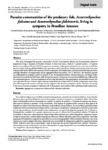Please use this identifier to cite or link to this item:
http://www.alice.cnptia.embrapa.br/alice/handle/doc/1047300Full metadata record
| DC Field | Value | Language |
|---|---|---|
| dc.contributor.author | HOSHINO, M. D. F. G. | pt_BR |
| dc.contributor.author | NEVES, L. R. | pt_BR |
| dc.contributor.author | TAVARES-DIAS, M. | pt_BR |
| dc.date.accessioned | 2016-06-17T11:11:11Z | pt_BR |
| dc.date.available | 2016-06-17T11:11:11Z | pt_BR |
| dc.date.created | 2016-06-17 | pt_BR |
| dc.date.issued | 2016 | pt_BR |
| dc.identifier.citation | Brazilian Journal of Veterinary Parasitology, v. 25, n. 2, p. 207-216, abr./jun. 2016. | pt_BR |
| dc.identifier.uri | http://www.alice.cnptia.embrapa.br/alice/handle/doc/1047300 | pt_BR |
| dc.description | This study investigated the parasite communities of wild Acestrorhynchus falcatus and Acestrorhynchus falcirostris populations living in sympatry in Brazilian Amazon. In these two hosts, a total of 12 parasite species e 1-9 parasite species were found per fish, and 10 of these species are metazoans. Eight species of parasites were common to both host species and four of them exhibited differences in abundance and/or prevalence. Parasite communities of the hosts were taxonomically similar (83%) and composed of both ectoparasites and endoparasites, and characterized by high prevalence and high abundance of endoparasites and an aggregated dispersion pattern. For A. falcirostris, the dominant parasite was Ichthyophthirius multifiliis, and for A. falcatus, it was Piscinoodinium pillulare. Shannon diversity and Berger-Parker dominance were similar for both hosts, while the parasites species richness and evenness showed differences influenced by the ectoparasites species. These two populations of hosts that inhabited the same geographical area had different sizes, but were exposed to the same infective stages, and acquired qualitatively and quantitatively similar endoparasites community, thus indicating that the amounts and types of prey congeneric that they were eating were similar. Therefore, the overlap in the same occurrence area play an important role in the parasite communities to these phylogenetically related hosts. | pt_BR |
| dc.language.iso | eng | eng |
| dc.rights | openAccess | eng |
| dc.subject | Aggregation | pt_BR |
| dc.subject | Animal parasite | pt_BR |
| dc.subject | Parasito animal | pt_BR |
| dc.title | Parasite communities of the predatory fish, Acestrorhynchus falcatus and Acestrorhynchus falcirostris, living in sympatry in Brazilian Amazon. | pt_BR |
| dc.type | Artigo de periódico | pt_BR |
| dc.date.updated | 2017-03-13T11:11:11Z | pt_BR |
| dc.subject.thesagro | Peixe de água doce | pt_BR |
| dc.subject.nalthesaurus | ectoparasites | pt_BR |
| dc.subject.nalthesaurus | freshwater fish | pt_BR |
| dc.subject.nalthesaurus | helminths | pt_BR |
| dc.subject.nalthesaurus | infection | pt_BR |
| riaa.ainfo.id | 1047300 | pt_BR |
| riaa.ainfo.lastupdate | 2017-03-13 | pt_BR |
| dc.contributor.institution | MARIA DANIELLE FIGUEIREDO GUIMARÃES HOSHINO, UNIFAP; LÍGIA RIGÔR NEVES, UNIFAP; MARCOS TAVARES-DIAS, CPAF-AP. | pt_BR |
| Appears in Collections: | Artigo em periódico indexado (CPAF-AP)  | |
Files in This Item:
| File | Description | Size | Format | |
|---|---|---|---|---|
| CPAFAP2016Parasitecommunitiesofthepredatory.pdf | 2,16 MB | Adobe PDF |  View/Open |









